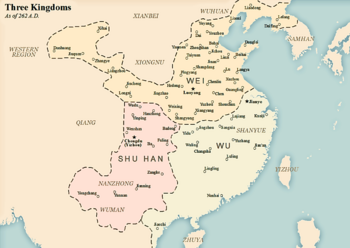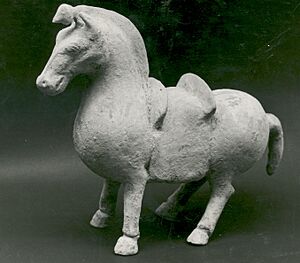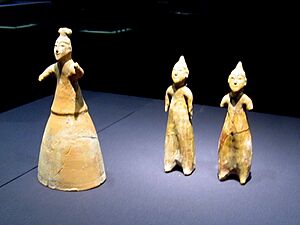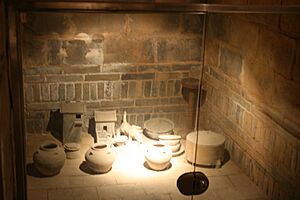Cao Wei facts for kids
Quick facts for kids
Wei
魏
|
|||||||||
|---|---|---|---|---|---|---|---|---|---|
| 220–266 | |||||||||

China in 262, with territories of Cao Wei in yellow
|
|||||||||
| Capital | |||||||||
| Common languages | Eastern Han Chinese | ||||||||
| Religion | Taoism, Confucianism, Chinese folk religion | ||||||||
| Government | Monarchy | ||||||||
| Emperor | |||||||||
|
• Dec 220 – Jun 226
|
Cao Pi | ||||||||
|
• Jun 226 – Jan 239
|
Cao Rui | ||||||||
|
• Jan 239 – Oct 254
|
Cao Fang | ||||||||
| Historical era | Three Kingdoms | ||||||||
|
• Abdication of Emperor Xian of Han
|
11 December 220 | ||||||||
|
• Eastern Wu declaring independence from Wei
|
222 | ||||||||
|
• Cao Wei conquers Shu Han
|
263 | ||||||||
|
• Abdication of Cao Huan
|
4 February 266 | ||||||||
| Population | |||||||||
|
• 260
|
4,432,881 (disputed) | ||||||||
| Currency | Chinese coin, Chinese cash (Wu Zhu) | ||||||||
|
|||||||||
| Today part of | |||||||||
| Cao Wei | |||||||||||||||||||||||||||||||||
|---|---|---|---|---|---|---|---|---|---|---|---|---|---|---|---|---|---|---|---|---|---|---|---|---|---|---|---|---|---|---|---|---|---|
| Traditional Chinese | 曹魏 | ||||||||||||||||||||||||||||||||
| Simplified Chinese | 曹魏 | ||||||||||||||||||||||||||||||||
| Hanyu Pinyin | Cáo Wèi | ||||||||||||||||||||||||||||||||
|
|||||||||||||||||||||||||||||||||
The Wei dynasty (220–266), also known as Cao Wei, was a powerful state in China during the Three Kingdoms period. It was founded in 220 by Cao Pi. He built upon the strong foundation created by his father, Cao Cao, during the end of the Han dynasty.
The first capital of Wei was Xuchang, but it was later moved to Luoyang. The name "Wei" was first used for Cao Cao when he became the Duke of Wei in 213. When Cao Pi became emperor in 220, it became the name of his new state. Historians often add "Cao" to "Wei" to avoid confusing it with other Chinese states that also used the name Wei.
Over time, the power of the ruling Cao family weakened. This happened after Cao Shuang, a leader helping the young emperor Cao Fang, was removed from power. Starting in 249, another powerful leader named Sima Yi and his family slowly took control. The last Wei emperors became like puppets, with the Sima family making all the decisions. In 266, Sima Yi's grandson, Sima Yan, forced the last Wei emperor, Emperor Yuan, to give up his throne. Sima Yan then started a new dynasty called the Jin dynasty.
Contents
The Rise of Cao Wei: How it Began
Founding the Wei Dynasty
Towards the end of the Eastern Han dynasty, a strong leader named Cao Cao took control of northern China. He was the chancellor, or chief minister, to the last Han emperor, Emperor Xian of Han. In 213, Emperor Xian gave Cao Cao the title "Duke of Wei" and control over ten cities. This area was called "Wei."
At this time, southern China was divided. Two other powerful warlords, Liu Bei and Sun Quan, controlled different parts. In 216, Emperor Xian gave Cao Cao an even higher title: "King of Wei."
Cao Cao passed away on March 15, 220. His son, Cao Pi, inherited his title as King of Wei. Later that year, on December 11, Cao Pi made Emperor Xian step down from the throne. Cao Pi then took power himself, officially starting the state of Wei.
However, not everyone agreed with Cao Pi's claim to be the new emperor. Liu Bei immediately challenged him and declared himself "Emperor of Han" a year later. Sun Quan was at first a vassal, or loyal follower, of Wei. But in 222, he declared his independence. He eventually named himself "Emperor of Wu" in 229.
To make it clear which "Wei" state historians are talking about, they often call this one "Cao Wei." This helps to tell it apart from other Chinese states with the same name.
Key Emperors and Major Conflicts
Rulers Cao Pi and Cao Rui
Cao Pi ruled as the first emperor of Wei for six years, until his death in 226. His son, Cao Rui, then became emperor and ruled until 239. During the reigns of both Cao Pi and Cao Rui, the Wei state was often at war with its two rivals, Shu Han and Eastern Wu.
Battles with Shu Han
Between 228 and 234, Zhuge Liang, the wise chancellor and regent of Shu Han, led several military campaigns. He attacked Wei's western borders, trying to capture Chang'an. This was a very important city on the way to Wei's capital, Luoyang.
Wei's armies, led by generals like Cao Zhen, Sima Yi, and Zhang He, successfully defended their lands. Shu Han did not manage to gain much territory in these expeditions.
Conflicts with Eastern Wu
On its southern and eastern borders, Wei fought many battles against Eastern Wu. These conflicts happened throughout the 220s and 230s. Some famous battles include Dongkou (222–223), Jiangling (223), and Shiting (228).
Most of these battles ended in a stalemate, meaning neither side won a clear victory. As a result, neither Wei nor Wu significantly expanded their territory during this time.
Wei's Campaign in Liaodong
In June 238, a powerful Wei general named Sima Yi led an army of 40,000 soldiers. Emperor Cao Rui sent him to invade Liaodong, a region that had been controlled by the Gongsun family for 40 years.
After a three-month siege, Sima Yi captured the main city of Xiangping. This led to Wei taking over the entire Liaodong region by late September of that year.
Wars with Goguryeo
Around this time, the Korean kingdom of Goguryeo grew stronger. It began to take over Chinese territories on the Korean peninsula. Goguryeo started the Goguryeo–Wei Wars in 242 by trying to capture a Chinese fort.
Wei responded by invading Goguryeo and defeating them. The city of Hwando was destroyed in 244 by Wei forces. The invasions forced the Goguryeo king to flee. They also broke the ties between Goguryeo and other Korean tribes, which hurt Goguryeo's economy. Although the king escaped and found a new capital, Goguryeo became much weaker. For about 50 years, Chinese historical records barely mentioned the state.
The Decline and Fall of Wei
Sima Family Takes Control
In 249, during the rule of Emperor Cao Fang, a powerful event changed everything. The regent Sima Yi took control of the government from his co-regent, Cao Shuang. This event showed that the emperor's power in Wei was crumbling. Cao Fang became a puppet ruler, with Sima Yi holding all the real power.
A Wei general named Wang Ling tried to rebel against Sima Yi, but his rebellion was quickly put down. Sima Yi passed away on September 7, 251. His eldest son, Sima Shi, took over his authority and continued to rule as regent.
In 254, Sima Shi removed Emperor Cao Fang from the throne. He claimed Cao Fang was planning a rebellion. Sima Shi then replaced him with Cao Mao as the new emperor. In response, two generals, Guanqiu Jian and Wen Qin, started a rebellion. Sima Shi crushed their uprising, but it took a heavy toll on his health. He died on March 23, 255, passing his power to his younger brother, Sima Zhao.
The End of Wei Rule
In 258, Sima Zhao put down another rebellion led by Zhuge Dan. This marked the end of a series of major uprisings against the Sima family's growing power. In 260, Emperor Cao Mao tried to take back control from Sima Zhao. However, he was killed by a military officer named Cheng Ji.
After Cao Mao's death, Cao Huan became the fifth ruler of Wei. But like his predecessor, Cao Huan was just a figurehead under Sima Zhao's control.
In 263, Wei armies, led by generals Zhong Hui and Deng Ai, successfully conquered the rival state of Shu Han. After this victory, Zhong Hui and a former Shu general, Jiang Wei, plotted to remove Sima Zhao from power. However, other Wei officials turned against them when they learned of the plan.
Sima Zhao himself received high honors and titles, becoming the Duke of Jin in 263 and then the King of Jin in 264. He died on September 6, 265, leaving the final step of taking the throne to his eldest son, Sima Yan.
On February 4, 266, Sima Yan forced Emperor Cao Huan to give up his throne. Four days later, on February 8, 266, Sima Yan established the Jin dynasty, replacing Wei. Cao Huan was allowed to live and passed away peacefully in 302.
Government and Society
How Wei Was Governed
The government system of Cao Wei was largely based on the Eastern Han dynasty. However, Cao Pi made some changes to strengthen the central government. He created two new government offices: the Central Inspectorate and the Mobile Imperial Secretariat. These new bodies helped to reduce the power of the older Imperial Secretariat and give more control to the emperor.
During this time, a minister named Chen Qun created the nine-rank system. This system was used to choose officials for government jobs. It was used by later dynasties until a new system, the imperial examination, was introduced much later.
Cao Pi believed that the Han dynasty fell because provincial governors had too much power. To prevent this, he reduced their role. Governors were only allowed to manage civil affairs in their provinces. Military matters were handled by separate military leaders.
Society in Cao Wei
Cao Wei society had a clear social structure. There was a powerful class of noble families who had many privileges. They were exempt from certain taxes and labor. This system allowed these aristocratic families to hold important government positions for generations.
Wealthy landowners and local leaders also became very powerful. They took in farming families and war refugees, who became their private workers and soldiers. These private soldiers formed their own armies. Even after wars ended, these workers remained tied to the noble families. They did not pay taxes or provide labor to the central government. Instead, they gave a large part of their harvest to their noble lords. This meant they were essentially bound to these powerful families.
Culture and Arts
The kaishu style of Chinese calligraphy, which is a very neat and clear way of writing Chinese characters, developed during this period. The first known master of this writing style was Zhong Yao, an official of Wei.
The Jian'an poetry style also became popular. A famous poet of this style was Cao Zhi, Cao Cao's son.
At the beginning of the Cao Wei dynasty, there was more freedom for thinkers and scholars. This led to the formation of new groups of intellectuals, such as the Seven Sages of the Bamboo Grove. These groups explored new ideas. However, these intellectual freedoms later ended when the Jin dynasty took over. The Sima family, who founded the Jin dynasty, preferred more traditional ideas.
List of Emperors
| Temple name | Posthumous name | Family name (in bold) and personal name | Reign | Era names and their year ranges | Notes |
|---|---|---|---|---|---|
| (N/A) | Emperor Gao 高皇帝 |
Cao Teng 曹騰 |
(N/A) | (N/A) | Cao Teng was given this special title after his death by Cao Rui. |
| (N/A) | Emperor Tai 太皇帝 |
Cao Song 曹嵩 |
(N/A) | (N/A) | Cao Song was given this special title after his death by Cao Pi. |
| Taizu 太祖 |
Emperor Wu 武皇帝 |
Cao Cao 曹操 |
216–220 | (N/A) | Cao Cao was given these special titles after his death by Cao Pi. |
| Shizu 世祖 |
Emperor Wen 文皇帝 |
Cao Pi 曹丕 |
220–226 |
|
The first emperor of Cao Wei. |
| Liezu 烈祖 |
Emperor Ming 明皇帝 |
Cao Rui 曹叡 |
227–239 |
|
Cao Pi's son and second emperor. |
| (N/A) | (N/A) | Cao Fang 曹芳 |
240–249 |
|
Was removed from the throne and became "Prince of Qi." |
| (N/A) | (N/A) | Cao Mao 曹髦 |
254–260 |
|
Was killed during an attempt to regain power. |
| (N/A) | Emperor Yuan 元皇帝 |
Cao Huan 曹奐 |
260–266 |
|
The last emperor of Cao Wei, forced to give up his throne. |
See also





